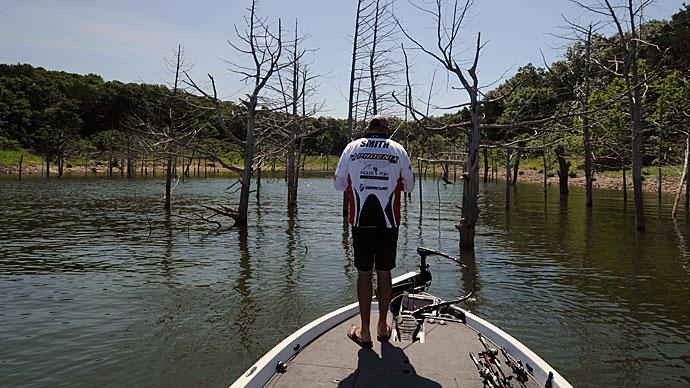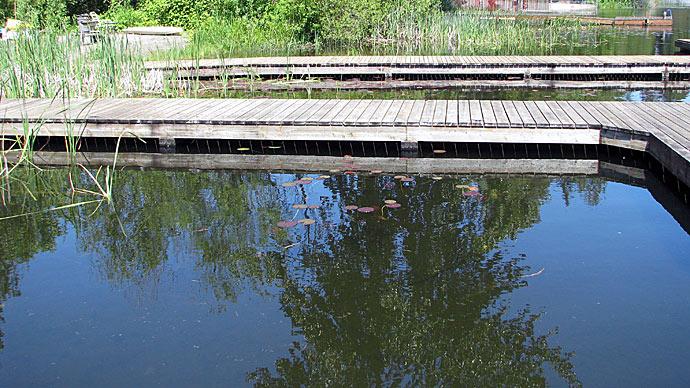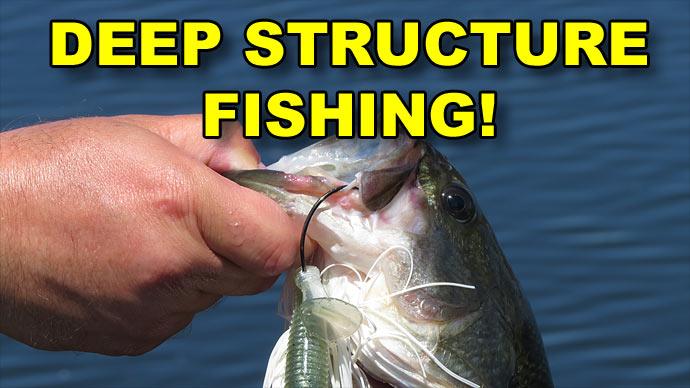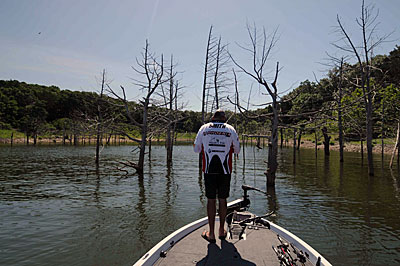
When early summer bass suspend in standing timber, Kevin Smith knocks on wood to get their attention.
The Missouri angler has plenty of experience fishing standing timber on his home waters of Truman Lake, where he has found a solution for catching early summer bass that have left the spawning banks and are setting up in their summertime haunts. “In the summertime, once the lake starts getting a thermocline and the shad are up in the water column, the bass aren’t going to be on the surface,” he said. “Those fish will stabilize in those trees in the middle of the coves and the deeper structure.”
The thermocline shows up as a horizontal line on the depth finder screen with balls of baitfish slightly above the line. Smith notices the thermocline in early summer at Truman is around 6 feet deep, so he will key on 8 to 20 feet deep trees.
Smith believes bass use the trees as ambush points to pick off shad swimming near the timber. “A lot of times, the thicker the tree, the better,” he said.
Truman Lake is filled with hardwood trees and cedars, and both hold bass. “I like fishing the cedar trees more, but sometimes that can be deceiving,” Smith said.
The Bassmaster Weekend Series National Championship qualifier prefers the cedar trees because the bushy cedars are more difficult to fish and thus receive less fishing pressure than the hardwoods. Cedars also provide a better canopy that creates more shade and cover for summertime bass. He suggests trying cedars and hardwoods, though, because bass sometimes prefer one type over the other from one day to the next.
Smith finds bass setting up in the timber from halfway back in coves to the mouth of the coves. Bass will be farther back in the coves if the fish are targeting shad, but bass will be closer to the main lake if the fish are relating to the current created by power generation.
When fishing through a jungle of standing timber, Smith targets specific targets. “If I can catch bass out of a tree row close to a point or a drop or maybe a flat, I can start determining the factors holding the fish,” Smith said. Another favorite target of Smith’s is a cluster of three trees among a row of single trees.
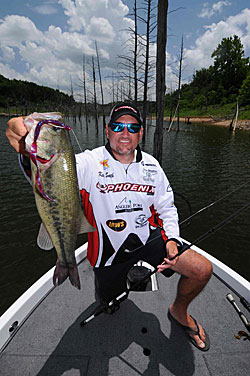
Bass suspended in the trees can be caught on squarebill crankbaits, but Smith prefers pitching soft plastics to these fish. He advises patience is required to catch suspended bass. “But it is not a slow technique,” said Smith, who has qualified for four B.A.S.S. Nation regionals. “You just have to get in the trees and cover a lot of water.”
Slower falling soft plastics produce best for Smith, so he Texas rigs his baits with a pegged 1/4-ounce weight. He pegs his weight to ensure the bait and sinker fall through the trees together. “If you don’t peg it, there will be opportunities where your bait will get hung up, your weight will continue to fall, and you are not working the area where you think you are.”
A 10-inch ribbon tail plastic worm and a Zoom Brush Hog are Smith’s top choices for tempting bass in the trees. He will occasionally pitch a Senko-style bait if the bite is extremely tough or fishing pressure is heavy.
His lure color choices depend on water clarity. Smith notes he needs about 2 feet of visibility to catch suspended bass in the trees so he can use natural colors for his Brush Hog, such as green pumpkin, watermelon candy, and watermelon/red flake. His favorite worm colors are blue fleck, watermelon candy, red shad, and tequila sunrise.
The tournament angler believes colors are inconsequential to the presentation because the bite is usually a reaction strike. “I think they see that bait falling through the tree in front of them, and if you hit them on the nose with it, they are going to eat it,” Smith said.
Smith starts his presentation by pitching past a tree and pulling the lure near the surface to the back side of the target. When the lure reaches the target, Smith lets it drop straight down the tree trunk. He wants to present the lure vertically, which prevents his bait from snagging on the limbs. After letting the bait sink to about 10 feet, Smith raises the lure until it hits a limb and then bounces it a couple of times before lifting it over the limb and letting it bang into another branch.
If a bass is there, the fish will usually hit quickly, so Smith never lets his lure sit very long in one spot. After bouncing his lure through the limbs on one side of the tree, Smith pitches to the other side of the cover and repeats the process before moving on to the next target. His gear for knocking on wood includes a 7-foot, 2-inch Lew’s medium-heavy action rod and Lew’s baitcast reel filled with 20-pound test fluorocarbon line.
Pitching to the trees for suspended bass usually produces quality bass for Smith rather than numbers of fish. Smith has caught five-fish limits in the 20- to 22-pound range on this tactic, which he notes are solid weights for bass still recuperating from the spawn.
BassResource may receive a portion of revenues if you make a purchase using a link above.


